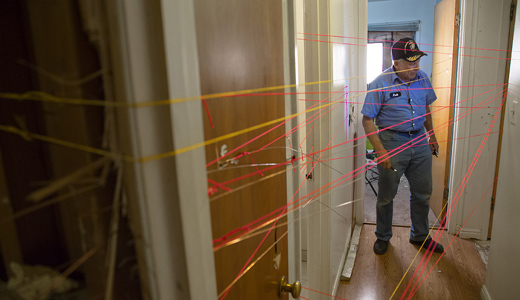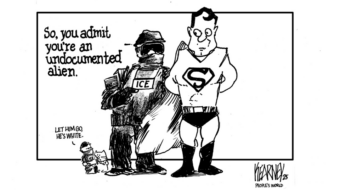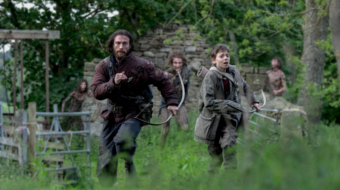
DURHAM, N.C. – Some 23,000 people have gone missing in Mexico since 2007, their relatives grieving in suspension over their fates, their nation paralyzed by fear. In a compact 73 minutes, director Bernardo Ruiz trains his lens in Kingdom of Shadows on three activists in this complicated cross-border sociology: Oscar Hagelsieb, a heavily tattooed federal agent from Socorro, Tex., who infiltrates drug cartels; a Texas rancher and one-time drug importer; and Sister Consuelo, a Catholic nun in Monterrey who keeps families’ hopes alive even in an objectively hopeless situation. An abstract story of widespread brutality is brought down to a human level where viewers can begin trying to make sense of it all.
Don Henry Ford, Jr., wasn’t making it as a farmer. As he sank ever deeper into debt in the 1980s, he stumbled into some marijuana smuggling, filling a truck every couple of weeks and raking in some major cash. But he was just a cog in a much larger machine, and had no idea how he fit into the larger picture. Only later did the contours of the major drug cartels emerge, and perhaps the scariest of them all were the Zetas, which grew out of the Mexican military, trained by the notorious School of the Americas.
Many pieces comprise this intricate puzzle. Many of them are imprinted “mandatory sentencing” – half of all federal prisoners in the U.S. are there for nonviolent drug offenses, many in privately owned prisons. Other pieces are from the “war on drugs” – illegality makes the drug trade that much more profitable. And of course “supply and demand” – the U.S. boasts the highest consumption of narcotics in the world. Marijuana’s pretty tame nowadays, as it’s legal in several states. Now coke and meth are more lucrative, and far more dangerous.
Every once in a while, the Mexican government stages a major narco operation, such as the one in the state of Nuevo León in 2011 involving 1500 troops. They’d detain 500-600 young people in a Saturday night raid and accuse them of being criminals. Some would never be seen again. Graves and elimination sites have been found, complete with the chemicals and barrels in which bodies are disposed of and reduced to ashes. Less than 5 percent of homicides in Mexico are ever prosecuted. No one can draw distinct lines dividing the police from the military from the cartels. The two monsters of corruption and total impunity protect the perpetrators, and faith in public institutions has too all but “disappeared.”
The gap in news coverage on Mexico serves as an excuse to lock up “undesirables,” i.e.., poor people of color for the most part, who will be missed only by other poor people of color. It fits the story that reporters are themselves targeted by the cartels – in fact Bernardo Ruiz’ first film, Reportero, was about exactly that. The 2014 incident of the 43 student disappearances from Ayotzinapa is briefly mentioned, clearly a late addition to the film.
SWAT teams vs. plants
William “Dub” Lawrence is the former sheriff of a rural Utah county in the 1970s, and is the Peace Officer in this 2015 film who had dedicated his life to confront the SWAT team that he himself founded. Why did Lawrence turn around on the militarization of America’s police forces? Well, the highly questionable standoff between cops and his own son-in-law, Brian Wood, resulting in the latter’s killing, had a lot to do with it.
In the aftermath of urban rebellions in the 1960s, SWAT teams emerged as a quasi-military response to widespread poverty, bad schools, substandard housing, limited opportunity – and the resistance that regularly broke out in cities across the nation. It did not take long for overwhelming aggression on the part of the police to become embedded in the popular understanding of law and order. No-knock raids became the norm especially once SWAT teams started being sent out to serve search warrants. And then, after the Vietnam War wound down in the mid-1970s, surplus military equipment was handed out to police departments with the requirement that it be used within a year. We began seeing Humvees and launch missiles in quiet suburbs.
Something of an obsessive-compulsive – which can be a useful trait when tracking down every last detail in a police procedural – Lawrence investigates this family death, and then goes on to look at other local cases where SWAT teams have far exceeded reasonable standards of protocol and common decency in their crazed pursuit of criminals. Oftentimes the “crime” is little more than some home-grown weed cultivation, or perhaps an unregistered firearm. But the price exacted is wildly out of proportion.
In one such raid, on a basement marijuana project, one officer was killed, and five others wounded. The subject also suffered major bodily harm. And what were they protecting us from? Plants. Lawrence reviews this case in extravagant detail. The filmmakers, following his lead, seem determined to trace the path of every bullet fired, the suspense building up as the incident takes shape through experienced forensic analysis.
May I make this earnest plea to filmmakers about musical scores? You know those ominous low, heavily reverbed bass tones that signal tension, anxiety, threat, fear, that are always ramped up to ear-numbing levels? (To call that music is a compliment I will not stoop to pay.) I’ve heard enough of it. These loud, menacing rumblings have become an annoying and intrusive viral infection; worst of all, they’ve simply become a cliché. It’s time to come up with other solutions. Filmmakers, you have been put on notice! I mention it here because Peace Officer is a major perp of this sonic crime.
Law enforcement officers are given time onscreen to deliver their defense of self-defense, but given all we have seen, they come across as oblivious to the deep social damage their actions are responsible for. In almost all these cases, it’s the police who initiated the action in the first place. In the Q&A following the screening, “Dub” Lawrence offered that one way to keep officers safer is not to create these situations that seem scripted to ending in death.
It probably was a useful strategy to single out a white, all-American crusader from Utah – a retired sheriff at that – to focus our attention on this issue. And most of the victims of excessive-force policing in this story are also Caucasian. I know it shouldn’t have to be this way, but white audiences who see this film will be that much more likely to respond to the questions the film poses. Black and poor communities already know all this: They long ago lost confidence in the kind of law enforcement that acts more like an occupying force.
During the years 2010-14 there were more deaths in Utah from police killings than in the drug trade. “We’re on the wrong track,” “Dub” Lawrence says. “I don’t think mankind is equipped to tolerate injustice forever.” His is the mainstream voice that may possibly be heard more clearly once the film goes into national release.
Created by Scott Christopherson and Brad Barber, Peace Officer won the festival’s Kathleen Bryan Edwards Award for Human Rights, and deserved it – it also snagged both the Audience Award and the Grand Jury Award at the 2015 SXSW Film Festival. Yet, at 109 minutes, Peace Officer is truly a piece too long, not an uncommon problem for documentaries. It could easily have been edited down by a good 20 minutes: We’ve really and truly gotten the point many times over. The tedious repetitiousness of the forensic research almost replicates a police academy instructional film. Too much information.
Striking at the heart of (T)ERROR
Exploring the murky tactics of the FBI, (T)ERROR focuses on a longtime FBI informant named Saeed “Shariff” Torres, former Black Panther and ex-convict, and himself a Muslim, who is corralled into a life of undercover work to avoid a 20-year jail term. The film uses a sting against a white Muslim convert in Pittsburgh as an example of Torres’ success. The FBI’s M.O. is to gradually ingratiate the agent into the target’s life and encourage him to say, do and publish things that will later be used against him. For young people radicalized by decades of U.S. attacks on Muslim and Arab cultures and nations, it’s not so hard to be drawn into a spider’s web of deception.
To their credit, the filmmakers do not particularly make a villain out of Torres. Rather, they portray him as doing what he’s got to do to keep a roof over his head and support a young son. Interestingly, people victimized by his acts as an informant do not appear to be especially angry at him. He is shown in other, positive, roles, such as the master baker that he would like to be, and as a dedicated musician.
What still mystifies is why Torres allowed the filmmakers such intimate access to his life, especially as this one episode unfolds. He did not let the FBI know that he was allowing filmmakers to document it. One can only surmise a kind of repentance, and a guarantee that once his face and reputation have been committed to the big screen, he’ll never be able to work for the FBI again.
It has been stated often before, but the three films reviewed here urgently reinforce the message: If some government agents in law enforcement behave unprofessionally, whether through the use of violence, extortion or spying, then all law enforcement suffers because it has sacrificed precious community trust which will be extremely difficult to ever regain.
Immediately upon my return home, I pick up the Los Angeles Times (Apr. 11) and see yet another article about FBI confidential informants intercepting one John Booker, a 20-year-old black Muslim known as Mohammed Abdullah Hassan, who supposedly planned to attack U.S. army troops. Once more, our nation saved! Yet the details smack of exactly the kind of entrapment (T)ERROR investigates in its elegant exposition. Of the 500-plus people charged with “terrorism” in the U.S. since 9/11, about half have involved an informant. To call these FBI agents “informants” is in my view a misnomer. I think something closer to “provocateurs” is much closer to the reality.
This suspenseful 93-minute film won the Reva and David Logan Grand Jury Award for filmmakers Lyric R. Cabral and David Felix Sutcliffe. Accepting the award, Sutcliffe related to the audience, “We recently showed the film to a former FBI agent who quit the bureau after 9/11, in protest of what was happening there. He called the film a colonoscopy on the domestic war on terror” (The News & Observer, April 13). For the first time in Full Frame’s 18 years, this top award was shared with another film, Kings of Nowhere, about residents of a Mexican village who remain in their homes after a flood.
In the Q&A with the directors following the screening, Sutcliffe stated that “we want to use this film to put pressure on representatives to create oversight.” A good idea. I hope it works.
Three earlier review articles on the 2015 Full Frame Documentary Film Festival have already appeared in People’s World: On human interest stories, the U.S. involvement in global politics, and the environment.
Photo from Peace Officer: “Dub” Lawrence traces the path of bullets in a SWAT team home raid. Peace Officer film










